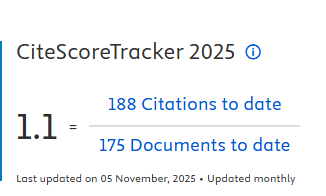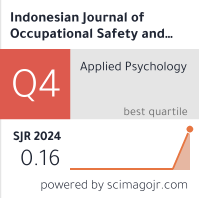How Optimal is The Visual Display Terminal (VDT) Work Station at The Public Health Faculty, Universitas Airlangga
Downloads
Introduction: The academic and student affairs department in the administration room of the Faculty of Public Health of Universitas Airlangga works using a Visual Display Terminal (VDT) with a sitting work position that has the potential to cause eye strain and several muscular disorders. This study aimed to describe the work station of VDT users in the administration room of the Public Health Faculty, Universitas Airlangga. Method: This research was an observational research using cross-sectional descriptive design. The population was the users of the VDT in the administration room of the Public Health Faculty, Universitas Airlangga, as many as 11 people. The sample used was total population. Data were collected using an observation sheet and then was analyzed descriptively. Result: The head position of all workers were optimal (100.0%); the majority of workers' visibility was optimal (54.5%); all table heights were optimal (100.0%); most of the elbow angel and keyboard position was not optimal (63.6%); the majority of mouse positions were optimal (54.5%); chair heights were not optimal (100.0%); most of the backrest and waist angle was optimal (72.7%); most of the workers' knee angles were not optimal (81.8%); most of the legroom were optimal (81.8%); all workstations did not have footing and document holders (100.0%), so they were considered not optimal. Conclusion: Most of the elements is considered as optimal, but some elements are not optimal, including elbow angle, the keyboard position, chair height, knee angle, footing, and document holder.
Keywords: work station, sitting work position, visual display terminal
‘Musculoskeletal Disorder Computer Users at the Central Statistics Agency of Sumatera Utara Province', Jurnal Kesehatan Global, 2(1), p. 47.
Baker, R. et al. (2018) ‘The Short Term Musculoskeletal and Cognitive Effects of Prolonged Sitting During Office Computer Work', International Journal of Environmental Research and Public Health, 15.
Cheng, X. et al. (2019) ‘Influence of Prolonged Visual Display Terminal Use and Exercise on Physical and Mental Conditions of Internet Sta ff in Hangzhou , China', International Journal of Environmental Research and Public Health, 16.
Irma, Lestari, I. and Kurniawan, A. R. (2019) ‘Faktor yang Berhubungan dengan Keluhan Subjektif Kelelahan Mata pada Pengguna Komputer', Jurnal Ilmiah Kesehatan Pencerah, 8(1), pp. 15–23.
Jalilpour, Y. et al. (2020) ‘Investigating the Musculoskeletal Disorders among Computer Users of Lordegan Health Network by ROSA Method and CMDQ Questionnaire', 4(2), pp. 563–569.
Keown, G. A. and Tuchin, P. A. (2018) ‘Workplace Factors Associated With Neck Pain Experienced by Computer Users : A Systematic Review', Journal of Manipulative and Physiological Therapeutics. Elsevier Inc.
Kumalapatni, N. W. S., Muliarta, I. M. and Dinata, I. M. K. (2020) ‘Gambaran Keluhan Muskuloskeletal dan Analisis Postur Tubuh pada Siswa Pengguna Komputer di SMK "G”, Denpasar, Bali', Jurnal Medika Udayana, 9(1), pp. 22–27.
Menteri Ketenagakerjaan Republik Indonesia (2018) ‘Peraturan Menteri Ketenagakerjaan Republik Indonesia Nomor 5 Tahun 2018 Tentang Keselamatan dan Kesehatan Kerja Lingkungan Kerja'.
Mohamad, S. S. and Rahman, M. A. (2018) ‘A Review on Prevalence and Risk Factors of Musculoskeletal Disorders (Msds) Among VDT Users', International Journal of Engineering & Technology, 7(3.20), p. 30.
Mork, R. et al. (2020) ‘Discomfort Glare and Psychological Stress During Computer Work: Subjective Responses and Associations Between Neck Pain and Trapezius Muscle Blood Flow', International Archives of Occupational and Environmental Health. Springer Berlin Heidelberg, 93(1), pp. 29–42.
Nopriadi et al. (2019) ‘Faktor yang Berhubungan dengan Kejadian Computer Vision Syndrome pada Karyawan Bank Factors Associated with the Incidence of Computer Vision Syndrome in', 15(2), pp. 111–119.
Pandey, R. et al. (2020) ‘Curse of The Technology-Computer Related Musculoskeletal Disorders and Vision Syndrome: A Study', International Journal of Research in Medical Sciences, 8(2), p. 661.
Parihar, J. K. S. et al. (2016) ‘Computer and Visual Display Terminals (VDT) Vision Syndrome (CVDTS)', Medical Journal Armed Forces India. Director General, Armed Forces Medical Services, 72(3), pp. 270–276.
Pradnyawati, M. A., Tunas, I. K. and Natalia Yudha, N. L. G. A. (2017) ‘Intervensi Sikap Kerja Dapat Menurunkan Kelelahan Kerja Dan Keluhan Muskuloskeletal Pada Karyawan Pt. Sucofindo Cabang Denpasar', Jurnal Kesehatan Terpadu, 1(1), pp. 30–37.
Restuputri, D. P., Puspita, D. and Mubin, A. (2019) ‘Pengukuran Risiko Kerja dan Lingkungan Fisik pada Departemen IT dengan Menggunakan Metode Rapid Office Strain Assessment (ROSA)', Jurnal Optimasi Sistem Industri, 18(2), p. 125.
Samudera, I. M. A., Muliarta, I. M. and H.A, L. M. I. S. (2019) ‘Gambaran Aspek Ergonomi Warnet di Kota Denpasar', Jurnal Medika Udayana, 8(12), pp. 1–6.
Sant, M. et al. (2017) ‘Differences in ergonomic and workstation factors between computer office workers with and without reported musculoskeletal pain', IOS Press, 57, pp. 563–572.
Siboro, B. A. H. (2019) ‘Analisa Postur Tubuh Kegiatan Input Data pada PT ABC', Jurnal Ergonomi dan K3, 4(1), pp. 1–6.
Suhardi, B. (2015) Perancangan sistem kerja. Surakarta: UPT Penerbitan dan Pencetakan UNS (UNS Press).
Swinton, P. A., Cooper, K. and Hancock, E. (2017) ‘Workplace Interventions to Improve Sitting Posture: A systematic Review', Preventive Medicine. Elsevier Inc.
Tarwaka (2015) Ergonomi Industri. II. Surakarta: Harapan Press.
Thatte, S. and Choudhary, R. (2020) ‘The Prevalence of Dry Eye in Young Individuals Exposed to Visual Display Terminal', The Clinical Ophthalmologist Journal, 1, pp. 15–18.
Woo, E. H. C., White, P. and Lai, C. W. K. (2016) ‘Ergonomics Standards and Guidelines for Computer Workstation Design and The Impact on Users' Health – A Review', Ergonomics, 59(3), pp. 464–475.

In order to be accepted and published by The Indonesian Journal of Occupational Safety and Health, Author(s) who submit an article should complete all the review process. The copyright of received articles assigned to the The Indonesian Journal of Occupational Safety and Health and Department of Safety and Health, Universitas Airlangga as publishers of the journal. The intended copyright includes the rights to publish articles in various forms (including reprints).
The Editorial Team of The Indonesian Journal Of Occupational Safety and Health and Department of Safety and Health strive to ensure that no errors occur in the articles that have been published, both data errors and statements in the article.
Users of this website will be licensed to use materials from this website following the Creative Commons Attribution-NonCommercial-ShareAlike 4.0 International License. No fees charged. Please use the materials accordingly.
------------------------------------------------------------------------------------------------------------------------------------------------------------------------------------------
Attribution ” You must give appropriate credit, provide a link to the license, and indicate if changes were made. You may do so in any reasonable manner, but not in any way that suggests the licensor endorses you or your use.
NonCommercial ” You may not use the material for commercial purposes.
ShareAlike ” If you remix, transform, or build upon the material, you must distribute your contributions under the same license as the original.







 How to Submit Articles in OJS
How to Submit Articles in OJS

























